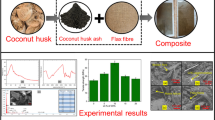Abstract
A cellulose-PCC composite was synthesised using the CaCl2 reaction with dimethyl carbonate (DMC) under alkaline conditions and in the presence of cellulose fibrils made from highly refined bleached softwood kraft pulp. The results showed that the ash content in the synthesised cellulose-PCC composite increased by increasing the reaction temperature from 25°C to 70°C, the reaction time from 3.5 min to 7.5 min and the cellulose consistency from 0.05 % to 0.1 %. The ratio of calcium carbonate generated to the calcium chloride used initially was increased by increasing the reaction temperature and time. The XRD pattern of the cellulose-PCC composite indicated no modification micro-crystal habit of the deposited CaCO3. The SEM images showed that the cellulose-PCC composite filler had a rhombohedral shape as opposed to the scalenohedral shape of common PCC. The paper filled with the cellulose-PCC composite had much higher bursting and tensile strengths, at a tearing strength similar to common PCC.
Similar content being viewed by others
References
Chen, X. Y., Qian, X. R., & An, X. H. (2011). Using calcium carbonate whiskers as papermaking filler. BioResources, 6, 2435–2441.
Ciobanu, M., Bobu, E., & Ciolacu, F. (2010). In-situ cellulose fibres loading with calcium carbonate precipitated by different methods. Cellulose Chemistry and Technology, 44, 379–387.
Dai, Z. G., Ni, Y. H., Court, G., & Li, Z. Q. (2011). Mitigating pitch-related deposits at a thermomechanical pulp-based specialty paper mill. Tappi Journal, 10(3), 51–56.
Deng, Y. L., Ragauskas, A. J., White, D., & Yoon, S. (2008). US Patent No. 20080087396. Washington, DC, USA: US Patent Office.
Dousi, E., Kallitsis, J., Chrissanthopoulos, A., Mangood, A. H., & Dalas, E. (2003). Calcite overgrowth on carboxylated polymers. Journal of Crystal Growth, 253, 469–503. DOI:10.1016/s0022-0248(03)01091-1.
Faatz, M., Gröhn, F., & Wegner, G. (2004). Amorphous calcium carbonate: Synthesis and potential intermediate in biomineralization. Advanced Materials, 16, 996–1000. DOI:10.1002/adma.200306565.
Fahmy, T. Y. A., & Mobarak, F. (2008). Nanocomposites from natural cellulose fibers filled with kaolin in presence of sucrose. Carbohydrate Polymers, 72, 751–755. DOI:10.1016/j.carbpol.2008.01.008.
Holik, H. (2006). Handbook of paper and board. Weinheim, Germany: Wiley.
Hubbe, M. A., Pawlak, J. J., & Koukoulas, A. A. (2008). Paper’s appearance: A review. BioResources, 3, 627–665.
Kang, T., & Paulapuro, H. (2006). New mechanical treatment of chemical pulp. Proceedings of the Institution of Mechanical Engineers Part E: Journal of Process Mechanical ýEngineering, 220, 161–166. DOI:10.1243/09544089jpme81.
Kitamura, M., Konno, H., Yasui, A., & Masuoka, H. (2002). Controlling factors and mechanism of reactive crystallization of calcium carbonate polymorphs from calcium hydroxide suspensions. Journal of Crystal Growth, 236, 323–332. DOI:10.1016/s0022-0248(01)02082-6.
Klungness, J. H., Ahmed, A., Ross-Sutherland, N., & Abu Bakr, S. (2000). Lightweight, high-opacity paper by fiber loading: Filler comparison. Nordic Pulp & Paper Research Journal, 15, 345–350.
Lin, T., Yin, X., Retulainen, E., & Nazhad, M. M. (2007). Effect of chemical pulp fines on filler retention and paper properties. APPITA Journal, 60, 469–473.
Maloney, T. C., Ataide, J., Kekkonen, J., Fordsmand, H., & Hoeg-Petersen, H. (2005). Changes to PCC structre in paper making. In: Proceeding of XIX National Technicelpa Conference, October 12–15, 2010. Lisbon, Portugal.
Shen, J., Song, Z. Q., Qian, X. R., & Yang, F. (2010). Carboxymethyl cellulose/alum modified precipitated calcium carbonate fillers: Preparation and their use in papermaking. Carbohydrate Polymers, 81, 545–553. DOI:10.1016/j.carbpol.2010.03.012.
Silenius, P. (2002). Improving the combination of critical properties and process parameters of printing and writing paper and paperboards by new paper-filling methods. Ph.D. thesis. Espoo, Finland: Helsinki University of Technology.
Silenius, P. (2003). European Patent No. 0930345. Munich, Germany: European Patent Office.
Song, D. L., Dong, C. X., Ragauskas, A., & Deng, Y. L. (2009). Filler modification engineering for improved paper properties and papermaking process. In TAPPI 2nd Annual Papercon’ 09 Conference — Solutions for a Changing World, May 31–June 3, 2009. St. Louis, MO, USA: Tappi.
Subramanian, R., Maloney, T., & Paulapuro, H. (2005). Calcium carbonate composite fillers. Tappi Journal, 4(7), 23–27.
Subramanian, R., Maloney, T. C., Kang, T., & Paulapuro, H. (2006). Calcium carbonate-cellulose fiber composites: The role of pulp refining. Paper Technology, 47(8), 27–31.
Subramanian, R., Fordsmand, H., & Paulapuro, H. (2007). Precipitated calcium carbonate (PCC) — cellulose composite fillers: Effect of pcc particle morphology on the production and properties of uncoated fine paper. BioResources, 2, 91–105.
Subramanian, R., Fordsmand, H., Paltakari, J., & Paulapuro, H. (2008). A new composite fine paper with high filler loading and functional cellulosic microfines. Journal of Pulp and Paper Science, 34, 146–152.
Tappi (1993). Ash in wood, pulp, paper and paperboard: combustion at 525°C, test method T211 om-93. Atlanta, GA, USA: Tappi.
Tappi (2005). Forming handsheets for physical tests of pulp, test method T 205 sp-12. Atlanta, GA, USA: Tappi.
Vengimalla, R., Chase, G. G., & Ramarao, B. V. (1999). Modeling of filler retention in compressible fibrous media. Separation and Purification Technology, 15, 153–161. DOI:10.1016/s1383-5866 (98)00092-6.
Zhao, Y. L., Kim, D. H., White, D., Deng, Y. L., Patterson, T., Jones, P., Turner, E., & Ragauskas, A. J. (2008). Developing a new paradigm for linerboard fillers. Tappi Journal, 7(3), 3–7.
Author information
Authors and Affiliations
Corresponding author
Rights and permissions
About this article
Cite this article
Mohamadzadeh-Saghavaz, K., Resalati, H. & Ghasemian, A. Cellulose-precipitated calcium carbonate composites and their effect on paper properties. Chem. Pap. 68, 774–781 (2014). https://doi.org/10.2478/s11696-013-0513-7
Received:
Revised:
Accepted:
Published:
Issue Date:
DOI: https://doi.org/10.2478/s11696-013-0513-7




